Xiongnu, a powerful nomadic people living on the Mongolian plateau, often harassed the south at the end of the Warring States Period.
奴人分布在蒙古高原上,战国末年以来,常向南方侵犯。
In 215 B. C. , the First Emperor had Meng Tian lead 300 000 soldiers to fend off these nomads, and finally recovered the south area of Hetao plain.
公元前215 年,秦始皇派蒙恬率军30万抗击匈奴,收复河套以南地区。
Then, Meng Tian crossed the Yellow River northward, repaired and augmented the old walls left by Qin, Zhao and Yan according to the terrain, and eventually linked these defense works together to form the Great Wall extending from Lintao ( modern Minxian County, Gansu Province) in the west to the Liaodong Peninsula in the east to protect the Northern agricultural areas.
蒙恬又北渡黄河,利用地势,修缮、增补旧秦、赵、燕长城,并将其连接起来,筑成西起临洮(今甘肃岷县)、东迄辽东的万里长城,用来保护北方农业区域。
Tens of thousands of families were migrated to Hetao subsequently, which played a positive role in land reclamation and frontier defence.
接着,秦又徙民几万家于河套。这对于边地的开垦和边防的加强起到了积极作用。
Besides the building of public projects, the emperor ordered a string of palaces built. For the construction of the Epang Palace alone, 700 000 peasants were conscripted ,while the building of his mausoleum took over 30 years to complete.
秦始皇下令建造了许多宫殿,仅阿旁宫一处就征用了70万人,而始皇陵的建造更是花了30年的时间才完成。
In order to continue his reign after his death, he also ordered the construction of the Terra-Cotta Army in the east of his mausoleum.
为了能在死后继续统治,秦始皇还下令在其陵墓以东修建兵马俑。
All of these activities required enormous levies of manpower and resources, not to mention repressive measures.
秦始皇的这一列系举措不但征用了大量的人力、物力,还以各种强制手段作为保障。
Endless labor, heavy taxation and harsh laws in the later years of the First Emperor’s reign started to provoke widespread social discontent.
频繁的徭役,沉重的赋税,加之残酷的刑罚令民众大为不满。





 。
。